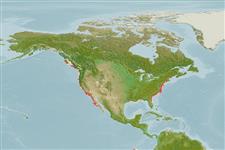Tubulanus pellucidus (Coe, 1895)
| Native range | All suitable habitat | Point map | Year 2050 |

|
| This map was computer-generated and has not yet been reviewed. |
| Tubulanus pellucidus AquaMaps Data sources: GBIF OBIS |
Google image |
No photo available for this species.
Classification / Names Populärnamn | synonymer | CoL | ITIS | WoRMS
Palaeonemertea | Tubulaniformes | Tubulanidae
Environment: milieu / climate zone / djupintervall / distribution range Ekologi
; djupintervall 0 - 20 m (Ref. 116109). Tropical
Distribution Länder | FAO områden | Ekosystem | Förekomster | Utplanteringar
Eastern Central Pacific and Western Central Atlantic: USA and Gulf of Mexico.
Length at first maturity / Size / Weight / Age
Könsmognad: Lm ? range ? - ? cm Max length : 0.3 cm TL hane/ej könsbestämd; (Ref. 969)
Life cycle and mating behavior Könsmognad | Reproduktion | Lek | Eggs | Fecundity | Larvae
Main reference
referenser | Koordinator | Medarbetare
Blake, J.A. 1993 6. Phylum Nemertea. p. 95-132. In Blake, J.A. and A. Lissner (eds.) Taxonomic Atlas of the Benthic Fauna of the Santa Maria Basin and Western Santa Barbara Channel. Vol. 1. Introduction, benthic ecology, oceanography, Platyhelminthes, and Nemertea. (Ref. 966)
IUCN Red List Status
(Ref. 130435: Version 2025-1)
CITES status (Ref. 108899)
CMS (Ref. 116361)
Threat to humans
Human uses
| FishSource |
Verktyg
Ytterligare information
Födosammansättning
Födointag
Predatorer
Max. ages / sizes
Length-weight rel.
Length-length rel.
Length-frequencies
Mass conversion
Abundans
Internet-källor
BHL | BOLD Systems | CISTI | DiscoverLife | FAO(Publication : search) | Fishipedia | GenBank (genome, nucleotide) | GloBI | Gomexsi | Google Books | Google Scholar | Google | PubMed | Tree of Life | Wikipedia (Go, sök) | Zoological Record


